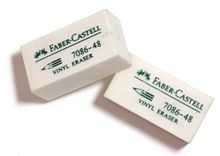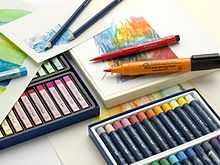Faber-Castell
 | |
| Type | Joint stock company |
|---|---|
| Industry | Stationery |
| Founded | 1761 |
| Founder(s) | Kaspar Faber |
| Headquarters | Stein (Middle Franconia), Germany |
| Area served | Worldwide |
| Key people | Anton Wolfgang Graf von Faber-Castell (CEO) |
| Products | Art materials, Writing instruments |
| Revenue | € 887 million (2005) |
| Employees | 6,500 (2006) |
| Website | www.faber-castell.com |
Faber-Castell is one of the world's largest manufacturers of pens, pencils, other office supplies (e.g., staplers, slide rules, erasers, rulers)[1] and art supplies,[2] as well as high-end writing instruments and luxury leather goods. It operates 14 factories and 20 sales units (six in Europe, four in Asia, three in North America, five in South America, and one each in Australia and New Zealand). The Faber-Castell Group employs a staff of approximately 7,000 and does business in more than 100 countries.[3]
Although its production began in Germany, only some of its premium pens are still manufactured there. Most of the company's consumer products are made in Brazil. Faber-Castell USA is headquartered in Cleveland, Ohio, and is part of the global network of Faber-Castell companies operating in countries such as Australia, Brazil, and Malaysia.[4]
Origin and history

Founded in 1761 at Stein near Nuremberg by cabinet maker Kaspar Faber (1730–84), the enterprise has remained in the Faber family for eight generations.[5] It opened branches in New York (1849), London (1851), Paris (1855), and expanded to Vienna (1872) and St. Petersburg (1874).[5] It opened a factory in Geroldsgrün where slide rules were produced. It expanded internationally and launched new products under Kaspar Faber's ambitious great-grandson, Lothar (1817–96).[5] In 1900, after the marriage of Lothar's granddaughter with a cadet of the Counts of Castell, the A.W. Castell enterprise took the name of Faber-Castell and a new logo, combining the Faber motto, Since 1761, with the "jousting knights" of the Castells' coat-of-arms.[6]
The Castell family were mediatised counts of the old Holy Roman Empire, and as such ranked with the reigning dynasties of Europe.[7] In 1901 the head of the family was granted the hereditary title of Prince by Luitpold, Prince Regent of Bavaria.[7] A descendant of the first prince, Count Alexander Friedrich Lothar von Castell-Rüdenhausen (1866–1928) married Baroness Ottilie von Faber (1877–1944), heiress of the Faber pencil "dynasty" in 1898.[7] Although the immensely wealthy Lothar had been ennobled in 1861 and made Baron von Faber in the Kingdom of Bavaria in 1881,[8][5] in the German Empire his daughter's marriage to a mediatised nobleman would have been deemed morganatic, and the Count's trafficking in commerce considered an act of social derogation for a member of the Hochadel, so Alexander renounced his birth rank prior to the marriage. He was granted the new hereditary title of Count von Faber-Castell by Luitpold, Prince Regent of Bavaria for the descendants of his marriage to the Faber heiress.[7] Although Alexander and Ottilie divorced in 1918, the Faber business trust had conferred headship of the company on Alexander,[5] who even kept the Fabers' renovated palace at Stein (commandeered to billet journalists during the Nuremberg trials, including Ernest Hemingway and John Steinbeck).[9]
In 1927 Alexander resumed his original name for himself, his second wife (born a countess, Margit Zedtwitz von Moravan und Duppau, 1886–1973), and their son, Count Radulf (1922–2004). His issue by the first marriage had never been considered dynasts of the House of Castell, but they inherited the vast Faber fortune and continue to include Castell in their name with the comital title.
Alexander and Ottilie's only son, Count Roland Lothar Wolfgang Christian Ernst Wilhelm von Faber-Castell (1905–78), inherited headship of the Faber-Castell companies from his parents.[5] By his second marriage in 1938 to Katharina Sprecher von Bernegg (1917–94), Roland was the father of the current head of the family, Count Anton-Wolfgang Lothar Andreas von Faber-Castell. Anton-Wolfgang was born in Bamberg 7 June 1941, was married (briefly) in Las Vegas on 16 June 1986 to Carla Mathilde Lamesch—mother of his only son, Count Charles Alexander von Faber-Castell, who was born in Zürich 20 June 1980—and he wed secondly, at Stein on 12 December 1987, Mary Hogan (b. 1951), by whom he has three daughters (Katharina, and the twins Sarah and Victoria).[8]
Anton-Wolfgang's niece, Countess Floria-Franziska von Faber-Castell (b. 1974) was married at Kronberg on 17 May 2003 in a much-publicised wedding attended by members of Europe's reigning families, to Donatus, Hereditary Prince of Hesse, a great-grandson of King Victor Emmanuel III of Italy and a grand-nephew of Princess Sophie of Greece and Denmark, sister of Prince Philip, Duke of Edinburgh. Floria is a daughter of Hubertus (1937–71), second son of Roland. Various branches of the Faber-Castell family still flourish, but in the past the Faber and Faber-Castell corporate holdings have usually passed to the eldest male of the patrilineage,[5] currently Count Anton-Wolfgang, third of Count Roland's five sons.[8]
Products
Faber-Castell is well known for its brand of PITT Artist pens. The pens, used by comic and manga artists such as Adam Hughes,[10] emit an India ink that is both acid-free and archival, and comes in a variety of colors.
The following chart contains all the Faber-Castell product lines.[11]
| Category | Range of products |
|---|---|
| Professional Art and Graphic | Pencils (graphite and color), pastels, charcoals, erasers, sharpeners |
| Kids & School Art and Graphic | Pencils, watercolors, brushes, markers, crayons, modeling dough, oil pastels, papers, connector pens |
| Technical Drawing | Mechanical pencils, refills |
| Pens | Fountain pens, ballpoint pens, refills |
From about 1880 to 1975 Faber-Castell was also one of the world's major manufacturers of slide rules, the best known of which was the 2/83N.
Gallery
-

Faber-Castell's Tri-Grip pencils with eraser caps and a sharpener.
-

Faber-Castell erasers
-

Faber Castell Polychromos
-

Faber-Castell 2/83N slide rule
-

Faber-Castell's Poly mechanical pencil
-

Notes and references
- ↑ Faber-Castell International. Office Products
- ↑ Faber-Castell International. Products for FineArts and Design
- ↑ Faber-Castell International. The company facts & figures
- ↑ Faber-Castell International. About Us
- ↑ 5.0 5.1 5.2 5.3 5.4 5.5 5.6 Faber-Castell International. The History of the Faber-Castell Company
- ↑ Faber-Castell International. The Company Logo
- ↑ 7.0 7.1 7.2 7.3 Almanach de Gotha. 1910. Perthes, p. 107, 109, 120–1. Deuxième Partie.
- ↑ 8.0 8.1 8.2 "At the Sharp End". The Economist. March 2007.
- ↑ Faber-Castell International. The Faber-Castell Castle
- ↑ Coulson, Steve. "Adam Hughes - Anatomy of a sketch, Pt3 - The Tools" YouTube; May 15, 2006; Accessed September 8, 2010
- ↑ Faber Castell products
External links
| Wikimedia Commons has media related to Faber-Castell. |
- Faber-Castell homepage (German)
- Faber-Castell International homepage
- Faber-Castell (USA)
- Graf von Faber-Castell
- Faber-Castell slide rule collection
- Faber-Castell: The future of the pencil
- Faber-Castell's eraser collection
- Faber-Castell products
- BBC visits Nuremberg in Germany to look at Staedtler and Faber-Castell's productive pencil rivalry. Audio, 28 minutes.
| |||||||||||||||||||||||||||||||||||||||||||||||
